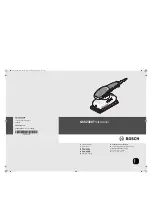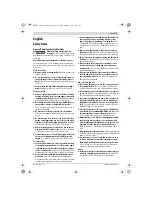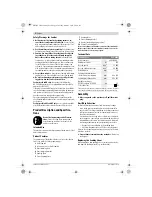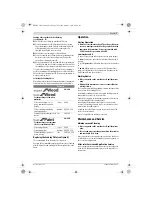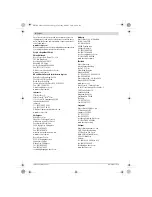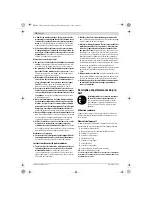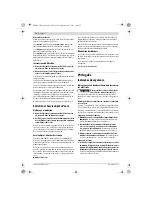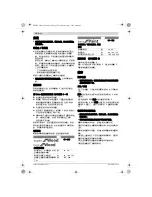
English |
7
Bosch Power Tools
1 609 92A 10D | (3.3.15)
Sanding Sheets without Velcro Backing
(see figures A–D)
Pull out the front clamping lever
6
and lift it up.
Feed the sanding sheet
7
all the way under the opened
front clamping bracket
8
. Fold the front clamping lever
6
all the way back in. Ensure that the sanding sheet is
clamped centrally and is not too short.
Pull out the rear clamping lever
3
and lift it up.
Place the sanding sheet
7
firmly around the sanding plate.
Guide the other end of the sanding sheet
7
under the
opened rear clamping bracket
4
.
Keep the sanding sheet
7
taut and fold the rear clamping
lever
3
all the way in to lock the sanding sheet. Ensure that
the sanding sheet is clamped centrally and is not too short.
To remove the sanding sheet
7
, pull out the rear clamping le-
ver
3
, lift it up and pull the sanding sheet out of its rear holder.
Pull out the front clamping lever
6
, lift it up and completely re-
move the sanding sheet.
Selecting the Sanding Sheet
Depending on the material to be worked and the required rate
of material removal, different sanding sheets are available:
Replacing the Sanding Plate (see figure E)
The sanding plate
5
can be replaced, if required.
Unscrew the 4 screws
10
completely and remove the sanding
plate
5
. Attach the new sanding plate
5
and tighten the screws
again.
Operation
Starting Operation
Observe correct mains voltage! The voltage of the pow-
er source must agree with the voltage specified on the
nameplate of the machine. Power tools marked with
230 V can also be operated with 220 V.
Switching On and Off
To save energy, only switch the power tool on when using it.
To
start
the machine, press the On/Off switch
1
and keep it
pressed.
To lock the
pressed
On/Off switch
1
, press the lock-on button
2
.
To
switch off
the machine, release the On/Off switch
1
or
when it is locked with the lock-on button
2
, briefly press the
On/Off switch
1
and then release it.
Working Advice
Before any work on the machine itself, pull the mains
plug.
Wait until the machine has come to a standstill before
placing it down.
The removal capacity during sanding is mainly determined by
the selection of the sanding sheet.
Only flawless sanding sheets achieve good sanding capacity
and extend the service life of the machine.
Pay attention to apply uniform sanding pressure; this increas-
es the working life of the sanding sheets.
Intensifiying the sanding pressure does not lead to an in-
crease of the sanding capacity, but to increased wear of the
machine and the sanding sheet.
A sanding sheet that has been used for metal should not be
used for other materials.
Use only original Bosch sanding accessories.
Maintenance and Service
Maintenance and Cleaning
Before any work on the machine itself, pull the mains
plug.
For safe and proper working, always keep the machine
and ventilation slots clean.
If the replacement of the supply cord is necessary, this has to
be done by Bosch or an authorized Bosch service agent in or-
der to avoid a safety hazard.
After-sales Service and Application Service
In all correspondence and spare parts order, please always in-
clude the 10-digit article number given on the type plate of
the machine.
Grain size
40–240
For the working of all wooden
materials
For coarse-sanding, e. g. of
rough, unplaned beams and
boards
coarse
40, 60
For face sanding and planing
small irregularities
medium 80, 100, 120
For finish and fine sanding of hard
woods
fine
180, 240
40–320
For the working of paint/enam-
el coats or primers and fillers
For sanding off paint
coarse
40, 60
For sanding primer
medium 80, 100, 120
For final sanding of primers
before coating
fine
180, 240, 320
OBJ_BUCH-2350-002.book Page 7 Tuesday, March 3, 2015 9:49 AM

